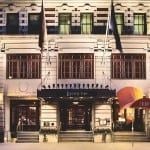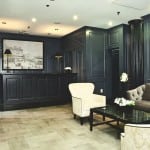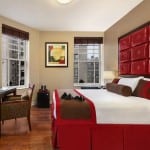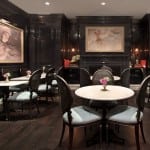Skift Take
Triumph Hotels' development of individual blogs and walking tours for each historic property celebrates a local, deep-rooted New York neighborhood experience.
- The Iroquois Hotel
- Hotel Chandler
- Cosmopolitan Hotel
- The Gershwin Hotel
- Hotel Belleclaire
- Washington Jefferson Hotel
- Lantern’s Keep at The Iroquois
- Juni Bar at Hotel Chandler
The new Triumph Hotels brand launched this month with six iconic Manhattan hotels for guests seeking “neighborhood-centric” experiences. Having welcomed celebrities from James Dean to Abraham Lincoln, the six hotels are: The Iroquois New York (Theater District), Hotel Chandler (Flatiron), Hotel Belleclaire (Upper West), Cosmopolitan Hotel (Tribeca), The Gershwin Hotel (NoMad), and Washington Jefferson Hotel (near Times Square).
The Iroquois and Chandler are the two luxury properties. The others are categorized as “affordable luxury.”
Many hotels and hotel groups are shifting toward the role of community portals these days, but the Triumph brand is taking that to a new level with surprisingly indepth digital communications and exclusive tours specific to each property. The motivation behind this is to incentivize guests to explore multiple properties and experience New York as the mosaic of communities it is.
Localism—physically, geographically and emotionally—is basically the brand promise for Triumph Hotels, anchored by the legacies of these architecturally and culturally important hotels.
We spoke with co-owner Gerald Barad about why he created Triumph Hotels.
Skift: Gerald, what does the Triumph Hotels brand stand for?
Gerald Barad: We’ve been running hotels and we’ve owned hotels since the 1950s. This is very much a family business and we’re native New Yorkers, so we have a deep connection to New York City, to the history of New York City, to the architecture of these hotels. And so the brand is very deeply tied to New York City, its history and these unique hotels.
In addition to that, one of our primary brand pillars is that we’re embracing the individual neighborhoods that our hotels exist in. As you know, New York is a series of different neighborhoods and every neighborhood has a different vibe, different attractions, different restaurants and different hotspots. So what we’re doing is we’re really creating neighborhood-centric properties. When you stay in one property, you have a specific experience that’s not only tied to Manhattan, but that’s also tied to the specific neighborhood.
For example at the Belleclaire, we have a package that includes having a picnic in Central Park just a short walk away. The Washington Jefferson has a package related to Broadway theater because it’s in the Theater District. As New Yorkers, we feel one of the benefits of staying at a Triumph property is we’re designing experiences for our guests that are uniquely New York.
Skift: Why did you decide to create the Triumph Hotels brand, and why now?
Gerald Barad: I think there are two primary factors. The first is that we have a lot more power both in terms of marketing and buying if you unite the hotels and operate them under one banner. And the other factor is that there’s been a tremendous amount of new development in New York City. It seems like every other block has a hotel sprouting up on it. Many of those are primarily corporate and new construction, and we really wanted to differentiate ourselves from all of this new product.
So we looked at our properties and said, what makes them special and what makes the experience staying in our hotels special? And we came to the conclusion that it’s all related to how unique the hotels are, how they have history, and how many of them were built in the early 1900s. They have original architecture, and you really feel the sense of history when you stay at our hotels.
Skift: What are you doing to maintain the essence of these historically important hotels while ensuring the experience doesn’t feel too dated?
Gerald Barad: We spent a significant amount of time, energy and money—we’ve spent $50 million already—renovating our properties, but we’re very careful to maintain the original architecture and the original experience beginning with our lobbies. As we’ve been doing that, we’ve found some really interesting discoveries like hidden skylights that were covered with three levels of sheetrock. We’ve uncovered floors that were under two or three levels of linoleum, and found beautiful marble floors.
We’re also creating some really exciting food and beverage outlets. For example at the Iroquois, we created Lantern’s Keep, which is like a little hidden speakeasy in the very back of the lobby. It’s kind of like a little hidden gem that only hotel guests know about.
Skift: How are you building relevancy with Millennials?
Gerald Barad: One of the other benefits of creating this brand is now we’re cultivating a lot of new technologies, and creating websites that work well on smart phones. We’re really starting to cultivate Twitter and Facebook so that we can start building a relationship with youthful demographics, because as you know it’s important that you resonate with that generation.
Skift: From our extensive research regarding Millennial travel behaviors, two-way connection and communication with a brand is paramount. Are you developing anything like that?
Gerald Barad: Actually we’re doing exactly that. We’re creating a neighborhood blog for each property so that when you stay at The Gershwin Hotel, it will be a blog that gives guests our choices for what our favorite outlets are in the NoMad neighborhood from native New Yorkers.
We’re going to create our own very specific guides as a benefit for our guests. When you stay in our neighborhoods, we’re going to tell you our favorite pizzeria, our favorite art gallery, our favorite clothing store, so that our guests will feel a very personal connection with the hotel. And they’ll have an opportunity to make comments, and also to suggest their own places that they visited in the same neighborhoods.
We’re also starting to build relationships with local walking tours for each neighborhood. Those will be among the services we’ll have that are neighborhood-specific, which will be created very shortly. So when you stay in one of our hotels, you’ll have the opportunity to explore that neighborhood and learn about the history of the hotel and the neighborhood, and how they relate to each other. And those tours will be specific for us and the properties.
Skift: What else is in the works?
Gerald Barad: We’re shortly going to be rolling out a brand loyalty program, and we’re going to have a number of different packages that encourage hotel guests to stay at one property for one visit, and then come back and stay at another property and discover a different architecture and a different neighborhood.
We’re also creating a flagship property in the NoMad area, which is one of the hottest areas in New York right now. We’re going to be doing a $30 million renovation of The Gershwin Hotel, and that’s going to include brand new rooms, a brand new lobby, and a very large food and beverage outlet that’s going to incorporate the entire lobby. That should be completed sometime in the next 12 to 18 months.
Skift: Gerald, which hotel is your favorite?
Gerald Barad: I love the architecture of the Belleclaire, but I’m working very intimately with The Gershwin Hotel, and we’re reimagining that property completely. We’re creating a new name for the hotel, and we’re really going to make that lobby and that hotel a major destination in New York City. When I look at The Gershwin, I see unbelievable potential, and I think it’s going to really have a major impact on the NoMad area. So right now, I’d have to say I’m pretty excited about The Gershwin conversion.
Greg Oates covers hotel/tourism development and travel brand media. He has toured over 1,000 hotels in 50+ countries. email / twitter
Have a confidential tip for Skift? Get in touch
Tags: new york state









